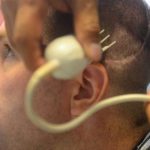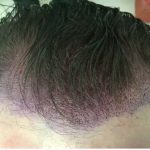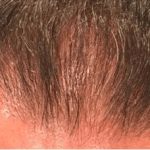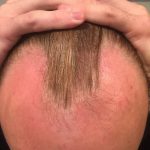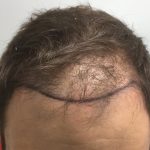The 7 Stages of Hair Loss & the Norwood Scale
The Norwood scale (or Hamilton-Norwood scale) is the leading classification system used to measure the extent of male pattern baldness. Men typically lose their hair in one of several common patterns over the course of many decades. The Norwood scale provides easy-to-reference images that indicate different stages of balding.
There are several other classification scales used by doctors, researchers, and hair transplant surgeons. Some classification scales include both sexes or focus on female pattern baldness.
The Norwood scale, however, is the measurement that’s most commonly used by clinicians when discussing male pattern baldness. It provides a reference point to diagnose the extent of baldness, discuss treatment options, and measure the effectiveness of treatment.
What are the 7 stages of hair loss?
The Norwood scale has seven stages. Each stage measures the severity and pattern of hair loss.
- Stage 1: No significant hair loss or recession of the hairline.
- Stage 2: There is a slight recession of the hairline around the temples. This is also known as an adult or mature hairline.
- Stage 3: The first signs of clinically significant balding appear. The hairline becomes deeply recessed at both temples, resembling an M, U, or V shape. The recessed spots are completely bare or sparsely covered in hair.
- Stage 3 vertex: The hairline stays at stage 2, but there is significant hair loss on the top of the scalp (the vertex).
- Stage 4: The hairline recession is more severe than in stage 2, and there is sparse hair or no hair on the vertex. The two areas of hair loss are separated by a band of hair that connects to the hair remaining on the sides of the scalp.
- Stage 5: The two areas of hair loss are larger than in stage 4. They are still separated, but the band of hair between them is narrower and sparser.
- Stage 6: The balding areas at the temples join with the balding area at the vertex. The band of hair across the top of the head is gone or sparse.
- Stage 7: The most severe stage of hair loss, only a band of hair going around the sides of the head remains. This hair is usually not dense and may be fine.
- Norwood class A: The class A variation of the Norwood scale is a slightly different and less common progression of hair loss. The main differences are that the hairline recedes back uniformly, without leaving an island of hair in the middle, and there is no bald area at the vertex. Instead, the hairline progresses directly from front to back.
What does hair loss look like for each stage?
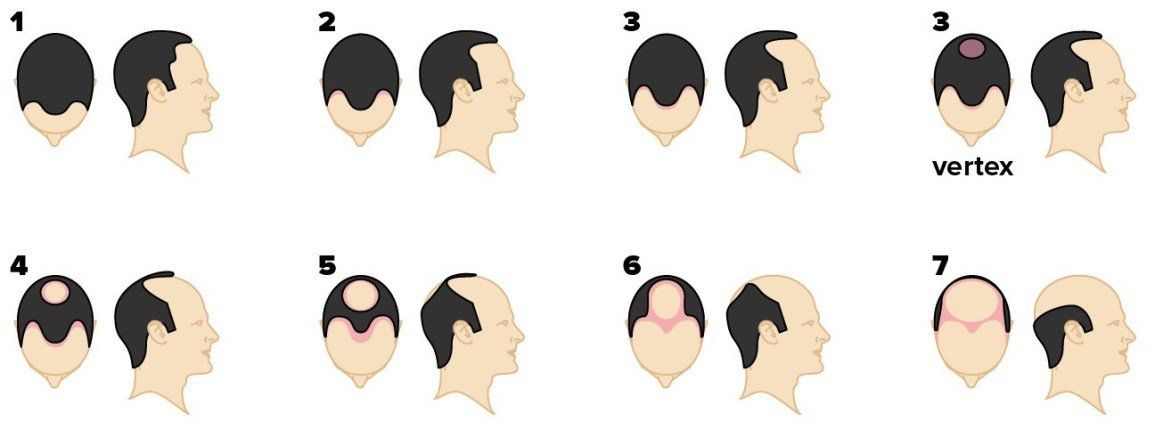
How is male pattern baldness diagnosed?
Hair loss can be diagnosed with a physical exam and medical history. Most hair loss is diagnosed as male pattern baldness, but if you’re young, female, or experiencing unusual hair loss, then your doctor may want to rule out other possible causes.
A dermatologist or hair loss specialist can examine your scalp to identify the pattern and degree of your hair loss. Your doctor may also tug at a few hairs and examine your hair follicles.
How is hair loss treated?
Hair loss treatments are most successful when started early. It’s easier to slow down hair loss than it is to stimulate new hair growth. Hair follicles that stop producing hair become dormant after about two years and can’t be reactivated. Once significant hair loss has occurred, surgical procedures may be the best option.
Over-the-counter (OTC) treatments
Treatments available without a prescription include:
- Minoxidil. Applied directly to the scalp, this medication (sold under the brand name Rogaine) can stop hairs from getting thinner. It can also stimulate hair growth on the top of the scalp. It can be combined with other treatments.
- Laser devices. There are various brushes, combs, and other devices that release laser light and are marketed as hair loss treatments. These devices might stimulate hair growth, but they haven’t been clinically proven to do so.
Prescription treatments
Depending on the severity of your hair loss and your success with OTC treatments, your doctor may recommend the prescription drug finasteride (Proscar, Propecia). Finasteride is a pill that’s approved by the U.S. Food and Drug Administration to treat men with hair loss. According to the American Academy of Dermatology, it slows hair loss in about 88 percent of men and stimulates regrowth in about 66 percent of men.
Procedures
There are also medical procedures available for the treatment of hair loss, including:
- Hair transplantation. Parts of your scalp that have good hair growth are removed, and hair follicles are transplanted to the balding areas.
- Scalp reduction. Some of the bald scalp is surgically removed, and the parts of the scalp with good hair growth are brought closer together. This can be combined with a hair transplant.
- Scalp expansion. Devices are inserted under the scalp for about three to four weeks to stretch the skin. This procedure may be done before a scalp reduction or as a stand-alone treatment.
- Scalp micropigmentation. Tiny tattoos can be applied to the scalp to create the appearance of a shaved head.
What causes male pattern hair loss?
Male pattern hair loss is caused by a combination of genetic, hormonal, and environmental factors. Your genes, inherited from both your parents, determine your sensitivity to hormones called androgens, particularly one called dihydrotestosterone (DHT).
Each strand of hair begins in a hair follicle and normally grows for two to six years before going into a resting phase and falling out. When the follicle begins to grow a new hair, the cycle starts again.
Increased androgens in the hair follicles can lead to shorter cycles of hair growth, lasting just weeks or months. DHT stimulates the process of miniaturization, which causes new hairs to grow shorter and thinner than before. Eventually, the hair follicles become too small to produce new hairs.
Is there a way to prevent male pattern hair loss?
Hair loss prevention and treatment go hand in hand. People begin balding at a wide range of different ages and lose hair at very different speeds, so it’s up to you to decide when to start taking preventive action. Hair loss treatments like minoxidil and finasteride work to prevent hair loss in most men.
The takeaway
The Norwood scale is a tool that you and your doctors can use to measure the extent of male pattern baldness. In the early stages, hair loss can be treated with medications. In the later stages, there are several surgical options.


